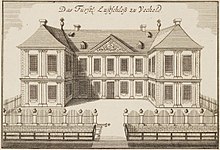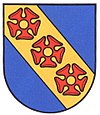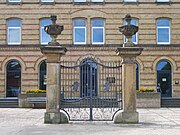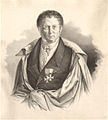Vechelde (Vechelde)
|
Vechelde
Vechelde municipality
|
||
|---|---|---|
| Coordinates: 52 ° 15 ′ 34 ″ N , 10 ° 22 ′ 0 ″ E | ||
| Height : | 77 m above sea level NHN | |
| Area : | 2.62 km² | |
| Residents : | 6318 (December 31, 2018) | |
| Population density : | 2,411 inhabitants / km² | |
| Incorporation : | March 1, 1974 | |
| Postal code : | 38159 | |
| Area code : | 05302 | |
|
Location of Vechelde in Lower Saxony |
||
|
Vechelde community center
|
||
Vechelde is a district of the municipality Vechelde in the district of Peine in Lower Saxony . The place is the administrative seat of the municipality of the same name.
geography
Geographical location
Vechelde is located in the lowlands of Braunschweig-Hildesheimer Lößbörde on the historic Cologne-Königsberg trunk road, Bundesstraße 1 . Its previous course crosses the floodplain on the eastern edge of the village and branches off in the center of the village in the direction of Hanover B 65 . Originally the place was a street village . The central function of Hildesheimer Straße is still reflected in the townscape today. In the course of its development history, the place grew to today's central place of the municipality with small town character.
Neighboring places
| Sir | Choose | Vechelade |
| Bettmar |

|
Denstorf |
| Liedingen | Kochingen | Wierthe |
history
Vechelde was mentioned in a document in 973 as Fehtlon, 1145 as Vechtla and around 1250 as Vechtelde. At the end of the 14th century, the Dukes of Braunschweig-Lüneburg built a castle there, which was pledged to the city of Braunschweig in 1392 . Vechelde remained under the administration of the city of Braunschweig until 1671, when the era of the independent city of Braunschweig was ended by the reconquest of the princes of Braunschweig-Wolfenbüttel.
In 1695 , Duke Rudolf August had the castle converted into a princely country seat, Vechelde Castle, by the master builder Hermann Korb for his morganatically wedded wife Rosine Elisabeth Menthe ("Madame Rudolfine") .
From 1712 the castle served as the residence of Princess Elisabeth Sophie Marie , the third wife of Duke August Wilhelm . For this purpose, the princess had the castle expanded, and another wing of the building and a castle chapel built. For the farm workers of the castle estate, about one kilometer north of the castle complex, she had a day laborer settlement built, from which today's Vechelder district of Vechelade developed.
On November 8, 1727, Prince Christian August von Anhalt-Zerbst and Johanna Elisabeth von Schleswig-Holstein-Gottorf married at Vechelde Castle . From this marriage, Sophie Auguste Frederike von Anhalt-Zerbst-Dornburg emerged on May 2, 1729, who later became Tsarina Katharina II.
Prince Ferdinand von Braunschweig-Wolfenbüttel , Duke of Braunschweig and Lüneburg, a brother-in-law of Frederick the Great, acquired Vechelde Castle in 1767. Ferdinand died in his residence Vechelde in 1792 after a long illness. Instead of his princely title, he only had the title “Landsherr von Vechelde” engraved on his coffin.
In 1804, Johann Peter Hundiker set up an internationally renowned educational institution in the baroque palace , supported by Duke Karl Wilhelm Ferdinand of Brunswick . The educational institution, the Philanthropin , existed until 1819.
With the Principality of Braunschweig-Wolfenbüttel, the place was incorporated into the Kingdom of Westphalia created by Napoleon in 1807 . Vechelde became the administrative seat of the canton Braunschweig-Land-West . The canton formed part of the Braunschweig district in the Oker department . After the dissolution of the Kingdom of Westphalia in 1813 and the constitution of the Duchy of Braunschweig , the state administration was reorganized. In 1814 the former cantons of Braunschweig-Land-West , Bettmar and Peine-Land were merged. The official seat was initially in Bettmar . On October 1, 1825, the administration and court were relocated to the Vechelde Landschloss as Amt Vechelde .
The castle building was demolished at the end of the 19th century and replaced by a neoclassical building. Until January 1, 1972, it served as the seat of the Vechelde District Court. Today it is used as a community center. The park was preserved.
Incorporations
The place was an independent municipality in the Braunschweig district until the regional reform of Lower Saxony . In the course of the regional reform, it was combined with 16 other localities to form the municipality of Vechelde on March 1, 1974. The community belongs to the district of Peine .
Population development
|
|

religion
Vechelde is the official seat of the provost of the Vechelde provost , a subdistrict of the Evangelical Lutheran Regional Church in Braunschweig .
The Catholic St. Gereon Church was built between 1955 and 1956. Today the church belongs to the congregation of the Heilig-Geist-Kirche in Braunschweig-Lehndorf and to the deanery of Braunschweig.
The church of the New Apostolic Congregation belongs to the Braunschweig church district of the New Apostolic Church of Central Germany .
politics
Local council
The 13 seats of the Vechelde / Vechelade local council are distributed as follows:
| Local election | SPD | CDU | Green | FDP | total |
| 11th September 2016 | 8th | 4th | - | 1 | 13 seats |
| September 11, 2011 | 8th | 4th | 1 | - | 13 seats |
| September 10, 2006 | 7th | 4th | 1 | 1 | 13 seats |
Local mayor
The local mayor is Olaf Marotz (SPD).
coat of arms
The draft municipal coat of arms of the community Vechelde comes from the Braunschweiger heraldist and author War Wilhelm .
- The coat of arms was approved by the municipal council on July 13, 1965 and approved by the Brunswick district president on January 12, 1966.
- The decision of the municipality of Vechelde , newly created on January 1, 1974 , to continue the coat of arms, was passed on May 6, 1975 by the municipal council and approved on October 31, 1975 by the Peine district.
| Blazon : "In blue a golden sloping bar , topped with three red roses with golden clusters." | |
| Explanation of the coat of arms: The municipal coat of arms is a color change of the former coat of arms of the von Vechelde family. Already with this coat of arms three silver roses were to be seen on a black sloping beam on a silver shield background. The blue-gold coloring expresses the affiliation of the community to the Braunschweig district, to which Vechelde belonged at that time. |
Culture and sights
Buildings
Jute gate
Europe's first jute spinning mill on the mainland was in Vechelde in 1861, founded by Julius Spiegelberg , closed in 1926 due to lack of work. During the Second World War, the Vechelde sub-command of the Neuengamme concentration camp was housed there. Polish Jews had to manufacture axles for the Braunschweig company Büssing as part of their armaments production. Today only the jute gate is standing. The former workers' apartments served as an AWO nursing home for the elderly before they became condominiums.
Parks and green spaces
Castle Park
The park at the former Vechelde Castle was laid out as a baroque castle garden by Duke Rudolf August around 1695 . After 1766, Duke Ferdinand von Braunschweig-Wolfenbüttel had the garden expanded and transformed into an English landscape garden. He had fish ponds created and the plantings supplemented with trees and shrubs from Italy and North America. Nothing has been preserved from the original 18th century design. After the park was used privately in the 19th century until the Vechelde District Court was closed in 1971, it was rebuilt in the mid-1970s. The supposed original baroque design was modeled on it. The 4.8 hectare park is now divided into a baroque style ground floor with a rondola and rose plantings, a lawn section and a forest-like section of the park.
Other attractions in the castle park include a group of figures " Hades at the rape of Persephone " of Baroque time and a sundial in classical style . In the palace gardens there is a monument in memory of Johann Friedrich Wilhelm Jerusalem , theologian and co-founder of the Collegium Carolinum founded in 1745, the forerunner of today's Technical University of Braunschweig . The monument was donated by Duke Ferdinand. In 1979 bronze busts of the duke and the pedagogue Johann Peter Hundiker were erected.
The former palace garden is freely accessible to the public.
- Castle Park
Bust of Johann Peter Hundiker,
Ben Siebenrock 1979
Sports
Vechelde's sports clubs with the largest number of members are MTV Vechelde and SV Arminia Vechelde. While MTV Vechelde offers 16 types of sport and sports activities, SV Arminia Vechelde focuses primarily on the two fields of table tennis and football.
In 2009, the MTV volleyball team again achieved promotion to the Lower Saxony / Bremen regional league. From 2012 to 2014 the team played in the third national volleyball league . The badminton division of MTV has been doing successful work in the youth field for years. In the adult area, the Lower Saxony championship was celebrated with the first team in 2001.
Regular events
Every year on the first Saturday in Advent, the 'Open Saturday' takes place, a street festival along the central shopping street, Hildesheimer Straße. The 'Trade and Industry Show' in the community center and the 'Castle Park Festival' in the castle park of the former moated castle in Vechelde take place alternately every year.
traffic
Vechelde is located on Bundesstrasse 1 between Braunschweig and Hildesheim and on Bundesstrasse 65 , which leads via Peine to Hanover. With a stop on the Hanover – Braunschweig railway line , the place has a connection to local rail transport .
A 4.1 km long northern bypass of the B1, which had been required for years, was opened to traffic on August 13, 2009. It was urgently needed to counteract the heavy intra-urban traffic volume of the shortest connection between Braunschweig and Hildesheim, which had grown due to the truck toll introduced in 2005.
education
In Vechelde there are schools of the general school forms of the lower secondary level ( Hauptschule , Realschule and Gymnasium ), a primary school for grades 1 to 4 and a special school with a focus on learning. The school building for the Vechelde orientation level was redesigned and expanded into a grammar school in 2004.
schools
- Albert Schweitzer School, elementary and secondary school with school kindergarten, special school with a focus on learning
- Vechelde secondary school
- Julius Spiegelberg High School
Personalities
Sons and daughters of the place
- Gustav Hartmann (1835–1894), lawyer, professor in Basel, Freiburg, Göttingen, and Tübingen
- Elisabeth Gnauck-Kühne (1850–1917), social scientist, teacher, publicist, pioneer of the Protestant and Catholic women's movement
- Wilhelm Klauditz (1903–1963), namesake of the Wilhelm Klauditz Institute for Wood Research in Braunschweig and employee in international organizations
- Willi Greite (1911–1992), sports teacher, administrative officer and sports official
- Y. Fongi (1936–2012), painter, draftsman, musician, object and concept artist
People connected to the place
- Duke Rudolf August of Braunschweig-Lüneburg (1627–1704)
- Raisin Elisabeth Menthe (1663–1701), also "Madame Rudolfine", morganatic wife of Duke Rudolf August von Braunschweig-Wolfenbüttel
- Elisabeth Sophie Marie of Schleswig-Holstein-Norburg (1683–1767), Princess of Schleswig-Holstein-Sonderburg-Norburg
- Duke Ferdinand von Braunschweig-Wolfenbüttel (1721–1792), Prussian Field Marshal General
- Benjamin Georg Peßler (1747–1814), Lutheran pastor and inventor
- Johann Peter Hundiker (1751–1836), teacher and ducal Brunswick school councilor
- Gerhard Julius Hundiker (1784–1854), educator and novelist
- Ferdinand Mackeldey (1784–1834), lawyer and professor at the Universities of Helmstedt, Marburg and Bonn
- Wilhelm Theodor Hundiker (1786–1828), educator and philologist
- Wilhelm August Förstemann (1791–1836), educator and mathematician
- Johann Heinrich Westphal (1794–1831), educator, astronomer and writer
- Eduard Schmidt von der Launitz (1797–1869), sculptor and art historian
- Hans Rudolf Schröter (1798–1842), pedagogue, mathematician and historian
- August von Geyso (1802–1861), Minister of State in the Duchy of Braunschweig
- Julius Spiegelberg (1833–1897), entrepreneur, founder of the first jute spinning mill on mainland Europe in Vechelde
- Georg Bode (1838–1910), lawyer, historian and natural scientist
- Hans Heldt (1886–1956), politician (FDP)
- Carl Lauenstein (1919–2009), farmer, politician (DP / CDU)
- Werner Kirschner (1938–2019), politician (SPD)
- Edda Schliepack (* 1940), politician (CDU)
- Christian Schwarzenholz (* 1951), politician (Greens, later PDS and SPD)
- Klaus Nührig (* 1958), writer and poet
- Picture gallery personalities
literature
- Wilhelm Bornstedt (Ed.): Chronicle of Vechelde 973 to 1973. 2 volumes, Verlag Dr. W. Bornstedt, Stöckheim near Braunschweig 1973.
- Wilhelm Bornstedt: From Braunschweig via the old "Landwehr" at the Raffurm to the former Vechelde moated castle (later Baroque pleasure castle, today Vechelde District Court) to Sievershausen, the old battleground from July 9, 1553 , Verlag Landkreis Braunschweig, Braunschweig 1965.
- Vechelde . In: Meyers Konversations-Lexikon . 4th edition. Volume 16, Verlag des Bibliographisches Institut, Leipzig / Vienna 1885–1892, p. 63.
Web links
Individual evidence
- ↑ a b c d Population figures. In: Website of the municipality of Vechelde. December 31, 2018, accessed March 11, 2019 .
- ↑ C. Venturini : The Duchy of Braunschweig in its previous and present condition. Verlag C. G. Fleckeisen, Helmstedt 1847, p. 186.
- ^ Friedrich Thöne: Wolfenbüttel. Spirit and splendor of an old residence. Bruckmann, Munich 1963, p. 140.
- ^ Karl Georg Wilhelm Schiller : Braunschweig's beautiful literature in the years 1745 to 1800, the age of the dawn of German beautiful literature . Holle Verlag, Wolfenbüttel 1845, p. 249 ( limited preview in Google Book search).
- ↑ G. Hassel and R. Bege: Geo-statistical description of the principalities of Wolfenbüttel and Blankenburg . tape 1 . Friedrich Bernhard Culemann, Braunschweig 1802, p. 479 ( limited preview in Google Book search).
- ↑ Karl Venturini: The Duchy of Braunschweig in its previous and present condition . C. G. Fleckeisen, Helmstedt 1847, p. 190 ( limited preview in Google Book Search).
- ↑ August Lambrecht: The Duchy of Braunschweig . A. Stichtenoth Publishing House, Wolfenbüttel 1863.
- ↑ a b c d Michael Rademacher: German administrative history from the unification of the empire in 1871 to the reunification in 1990. Braunschweig district (→ see under: No. 64 ). (Online material for the dissertation, Osnabrück 2006).
- ^ Ulrich Schubert: Community directory Germany 1900 - Braunschweig district. Information from December 1, 1910. February 3, 2019, accessed on July 24, 2019 .
- ^ Federal Statistical Office (ed.): Official municipality directory for the Federal Republic of Germany . Final results according to the September 13, 1950 census. Volume 33 . W. Kohlhammer Verlag, Stuttgart / Cologne August 1952, p. 60 , col. 2 ( digital version [PDF; 26.4 MB ; retrieved on April 28, 2019] Braunschweig district, p. 69).
- ^ Council information system of the municipality of Vechelde , accessed on November 9, 2016.
- ^ Drafts of coat of arms by Wilhelm Krieg. In: Wikimedia Commons. Retrieved July 24, 2019.
- ↑ a b c d Arnold Rabbow: Braunschweigisches Wappenbuch . The coats of arms of the communities and districts in the urban and rural districts of Braunschweig, Gandersheim, Gifhorn, Goslar, Helmstedt, Peine, Salzgitter, Wolfenbüttel and Wolfsburg. Ed .: Braunschweiger Zeitung, Salzgitter Zeitung and Wolfsburger Nachrichten. Eckensberger & Co Verlag, Braunschweig 1977, DNB 780686667 , p. 96 .
- ↑ Main statute, § 2 national emblem / official seal, paragraph 1. (PDF; 39 kB) In: Website of the municipality of Vechelde. December 19, 2011, p. 1 , accessed on July 24, 2019 (the unheraldic addition, “The bar runs from top left to bottom right,” which is not necessary for exact blazon, is omitted here).
- ↑ Axel Richter: The Vechelde sub-command of the Neuengamme concentration camp. For the use of concentration camp prisoners in arms production . Ed .: Vechelde municipality . Vechelde 1985.
- ^ Christian Cay Lorenz Hirschfeld : Theory of garden art. Vol. 5, Verlag M. G. Weidmanns Erben und Reich, Leipzig 1782, p. 316.























